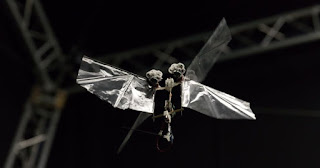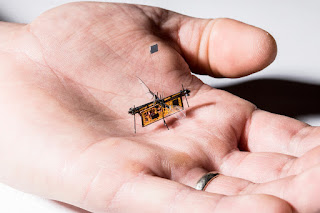Flying Robot with Insect Agility & Speed

Novel, Tiny Robot Has Big Applications for Drones DelFly Robot - Image Courtesy of Delft University New Robot Mimics Insect Flight Researchers at Delft University of Technology in The Netherlands have developed a novel flying robot that mimics the flight control and dynamics of insects. Its flying wings beat 17 times per second. And it generates enough force to stay airborne and controls the flight by slight changes in wing motion. DelFly Nimble The engineers have named it DelFly Nimble. The tiny robot is autonomous. It can hover on the spot, do 360० flips and fly any direction with agility like an insect. Right now it has top speeds of 15.5 mph and excellent power efficiency with a flight range of 1 km on a fully charged battery. Important Applications DelFly Nimble has exceptional flight qualities which open up new drone applications. Scientists say it's also exceptionally well suited to advance biological and engineering research i...
